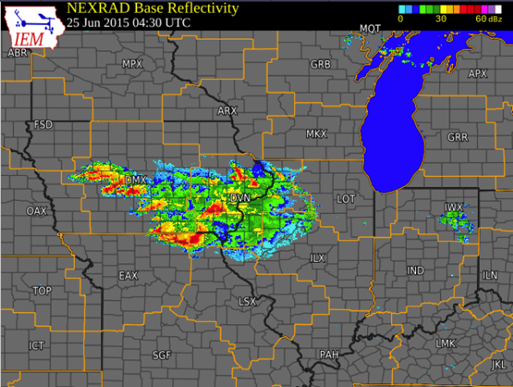Changes in land surface conditions displace modeled precipitation
Submitter
Fast, Jerome D
— Pacific Northwest National Laboratory
Area of Research
Cloud-Aerosol-Precipitation Interactions
Journal Reference
Yang Z, A Varble, L Berg, Y Qian, S Tai, J Chen, W Gustafson, Z Feng, and Y Liu. 2023. "Sensitivity of Precipitation Displacement of a Simulated MCS to Changes in Land Surface Conditions." Journal of Geophysical Research: Atmospheres, e2022JD037642, 10.1029/2022JD037642.
Science

Figure 1. Radar data shows a mesoscale convective system in the United States Midwest on June 25, 2015. (Image courtesy of Iowa Environmental Mesonet|Iowa State University.)
The timing and location of precipitation associated with mesoscale convective systems (MCSs) are sensitive to low-level moisture in the atmosphere. Previous studies suggest that the displacement error in a modeled MCS over Iowa from June 24 to 25, 2015 was caused by an underrepresentation of low-level moisture. Researchers conducted a series of simulations to understand the effect of moisture changes on the MCS precipitation. Adding moisture directly to the air close to the ground makes the storm form closer to its observed location, while changes to the moisture in the soil can make the storm move further away. The impact of irrigation on the moisture near the ground depends on the length of the simulation. Overall, this study finds that more moisture in the air close to the ground leads to a more unstable atmosphere that causes the storm to form more quickly, which better matches observations.
Impact
MCSs are a collection of organized lines or clusters of moist convection that produce heavy and extreme warm-season rainfall, significantly affecting the hydrologic cycle. While progress has been made to improve physical understanding of the organization and maintenance of MCSs, the predictability of MCSs remains limited in terms of the timing, location, and rainfall intensity. Numerical models often have biases in low-level moisture, which may lead to substantial errors in precipitation. Therefore, understanding potential sources of error in low-level moisture and how they may affect MCS displacement is crucial for better comprehension and prediction of intense precipitating MCSs.
Summary
Researchers investigated how the land surface affects the precipitation produced by a cluster of thunderstorms, an elevated MCS, that occurred in Iowa between during June 24-25, 2015. Researchers used semi-idealized simulations to study the effect of moisture on the location and amount of precipitation from the storm. In general, numerical simulations place the MCS east of the observed location. Adding moisture directly in the low-level atmosphere in the semi-idealized experiments reduces this displacement error. Adding soil moisture is not equivalent to adding atmospheric moisture because it cools temperature and induces low-level divergence, causing the MCS to move further to the east. Short-term irrigation simulations decrease atmospheric moisture and move the MCS to the east, but long-term irrigation does the opposite. Despite the lack of low-level moistening in the perturbed soil moisture and short-term irrigation experiments, the sensitivity of the MCS to low-level moisture is similar in all runs.
Keep up with the Atmospheric Observer
Updates on ARM news, events, and opportunities delivered to your inbox
ARM User Profile
ARM welcomes users from all institutions and nations. A free ARM user account is needed to access ARM data.


















